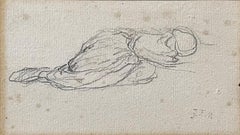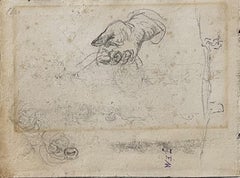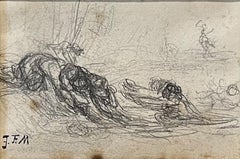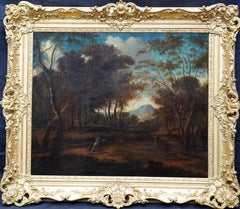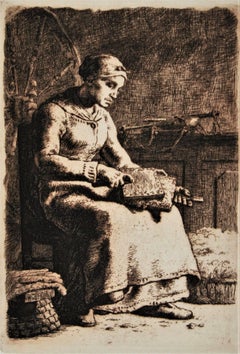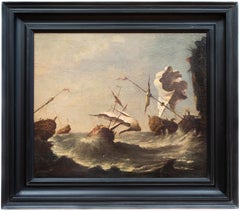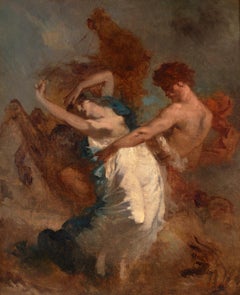Jean François Millet Art
to
1
4
2
5
2
4
2
4
1
1
Overall Height
to
Overall Width
to
1
1
3
2
2
1
1
1
1
1
1
1
5
6
6,952
3,300
2,514
1,213
3
2
1
1
1
Artist: Jean François Millet
Jean Francois Millet, "La Boullie (The Porridge)", Drypoint Etching, 1861
By Jean François Millet
Located in Long Island City, NY
Etching printed in brownish black on light tan Chine collé, 1861. Image measures 6 x 5 inches, displayed in a 15.5 x 12.5 inch frame. Etched signature and date lower left. A very goo...
Category
1860s Impressionist Jean François Millet Art
Materials
Drypoint, Etching, Intaglio
Study of the sleeping woman from "La méridienne"
By Jean François Millet
Located in Barbizon, FR
Study of the sleeping woman from “La meridienne”,
Black pencil drawing on paper (sketchbook), stamped from the widow's sale in 1894 (Lugt L.3728) lower left, Paper 9.2x13.2 cm, drawi...
Category
19th Century Barbizon School Jean François Millet Art
Materials
Paper, Pencil
Study of a hand and landscape, on the back, study of cow legs and hooves
By Jean François Millet
Located in Barbizon, FR
Black pencil drawing, stamp from the widow’s sale in 1894 (Lugt L. 3728), dimensions 10.5x14.2cm. This is a detail study of the hand of the peasant holding a lunge rein, represented...
Category
19th Century Barbizon School Jean François Millet Art
Materials
Pencil
Study of "Hylas and the nymphs", and on the backside, study of a peasant
By Jean François Millet
Located in Barbizon, FR
Black pencil drawing, stamped from the widow’s sale in 1894 (Lugt L. 3728), dimensions 7x10.2cm. It is most likely the first thought for this subject, circa 1846.
On the reverse si...
Category
19th Century Barbizon School Jean François Millet Art
Materials
Pencil
Wooded Landscape with Diana Hunting - 17thC Old Master French art oil painting
By Jean François Millet
Located in London, GB
A original large French Old Master oil on canvas which is by Millet (1642-1679) and was painted circa 1675. This large canvas is in good clean condition and depicts a wooded landscap...
Category
17th Century Old Masters Jean François Millet Art
Materials
Oil
La Cardeuse (Woman Carding Wool)
By Jean François Millet
Located in Storrs, CT
La Cardeuse (Woman Carding Wool). c. 1858. Etching. Delteil, Melot 15. only state. 10 x 7 (sheet 12 3/8 x 9 1/2). Illustrated: Print Collector's Quarterly 25 (1938): 146; Keppel, The...
Category
1850s Barbizon School Jean François Millet Art
Materials
Etching
Related Items
Shipping in Stormy Waters, Attributed to Italian Artist Francesco Guardi
By Francesco Guardi
Located in Stockholm, SE
The splendour of the tragic sea
Francesco Guardi and maritime painting in Venetian art
No Venetian painter was a stranger to the sea. After all, Venice was not only one of the most prominent ports of the Mediterranean, but indeed a city literally submerged in the ocean from time to time. Curiously however, the famous Venetian school of painting showed little interest in maritime motifs, favouring scenes from the iconic architecture of the city rather than seascapes. That is why this painting is a particularly interesting window into not only the painter Francesco Guardi himself – but to the significance of the element of water in art history, in absence as well as in the centre of attention.
Whether it be calm, sunny days with stunning views of the palaces alongside the canals of Venice or – more rarely – stormy shipwrecking tragedies at sea, water as a unifying element is integral to the works of painter Francesco Guardi (1712–1793). During his lifetime, Venetian art saw many of its greatest triumphs with names like Tiepolo or Canaletto gaining international recognition and firmly establishing Venice as one of the most vibrant artistic communities of Europe. While the city itself already in the 18th century was something of an early tourist spot where aristocrats and high society visited on their grand tour or travels, the artists too contributed to the fame and their work spread the image of Venice as the city of romance and leisure to an international audience, many of whom could never visit in person.
Still today, the iconic image of Venice with its whimsical array of palaces, churches and other historic buildings is much influenced by these artists, many of whom have stood the test of time like very well and remain some of the most beloved in all of art history. It was not primarily subtility, intellectual meanings or moral ideals that the Venetian art tried to capture; instead it was the sheer vibrancy of life and the fast-paced city with crumbling palaces and festive people that made this atmosphere so special. Of course, Venice could count painters in most genres among its residents, from portraiture to religious motifs, history painting and much else. Still, it is the Vedutas and views of the city that seems to have etched itself into our memory more than anything else, not least in the tradition of Canaletto who was perhaps the undisputed master of all Venetian painters.
Born into his profession, Francesco lived and breathed painting all his life. His father, the painter Domenico Guardi (1678–1716) died when Francesco was just a small child, yet both he and his brothers Niccolò and Gian Antonio continued in their fathers’ footsteps. The Guardi family belonged to the nobility and originated from the mountainous area of Trentino, not far from the Alps. The brothers worked together on more challenging commissions and supported each other in the manner typical of family workshops or networks of artists. Their sister Maria Cecilia married no other than the artist Giovanni Battista Tiepolo himself, linking the family to the most renowned Venetian name of the time. During almost a decade, Guardi worked in the studio of Michele Giovanni Marieschi, sometimes simply known as Michiel, a painted similar in both style and motif. Canaletto is, however, the artist Guardi is most often compared to since they shared a mutual fascination for depicting the architecture and cityscape of Venice.
During the course of his career, Guardi tried his hand in many different genres. He was as swift in painting landscapes, Vedutas of Venice, sacred motifs, interiors and architectural compositions as he was in a number of other motifs. His style is typical of the Venetian school but also distinct and personal once we look a little closer. There is an absolute certainty in the composition, the choice of which sometimes feels like that of a carefully calculated photograph – yet it is also very painterly, in the best sense of the word: fluid, bold, sensitive and full of character. The brushwork is rapid, intense, seemingly careless and extraordinarily minute at the same time; fresh and planned in a very enjoyable mixture. His interiors often capture the breath-taking spacious glamour of the palaces and all their exquisite decor. He usually constructed the motif through remarkably simple, almost spontaneous yet intuitively precise strokes and shapes. The result was a festive, high-spirited atmospheric quality, far away from the sterile and exact likeness that other painters fell victim to when trying to copy Canaletto.
The painting here has nothing of the city of Venice in it. On the contrary, we seem to be transported far away into the solitary ocean, with no architecture, nothing to hold on to – only the roaring sea and the dangerous cliffs upon which the ships are just moments away from being crushed upon. It is a maritime composition evoking both Flemish and Italian precursors, in the proud tradition of maritime painting that for centuries formed a crucial part of our visual culture.
This genre of painting is today curiously overlooked, compared to how esteemed and meaningful it was when our relationship to the sea was far more natural than it is today. When both people and goods travelled by water, and many nations and cities – Venice among them – depended entirely on sea fare, the existential connection to the ocean was much more natural and integrated into the imagination. The schools and traditions of maritime art are as manifold as there are countries connected to the sea, and all reflect the need to process the dangers and wonders of the ocean.
It could symbolize opportunity, the exciting prospects of a new countries and adventures, prospering trade, beautiful scenery as well as war and tragedy, loss of life, danger and doom. To say that water is ambivalent in nature is an understatement, and these many layers were something that artists explored in the most wondrous ways. Perhaps it takes a bit more time for the modern eye to identify the different nuances and qualities of historic maritime paintings, they may on first impression seem hard to differentiate from each other. But when allowing these motifs to unfold and tell stories of the sea in both fiction and reality – or somewhere in between – we are awarded with an understanding of how the oceans truly built our world.
In Guardi’s interpretation, we see an almost theatrically arranged shipwrecking scene. No less than five ships are depicted right in the moment of utter disaster. Caught in a violent storm, the waves have driven them to a shore of sharp cliffs and if not swallowed by the waves, crushing against the cliffs seems to be the only outcome. The large wooden ships are impressively decorated with elaborate sculpture, and in fact relics already during Guardi’s lifetime. They are in fact typical of Dutch and Flemish 17th century ships, giving us a clue to where he got the inspiration from. Guardi must have seen examples of Flemish maritime art, that made him curious about these particular motifs. One is reminded of Flemish painters like Willem van de Velde and Ludolf Backhuysen, and this very painting has indeed been mistakenly attributed to Matthieu van Plattenberg...
Category
18th Century Old Masters Jean François Millet Art
Materials
Canvas, Oil
Free Shipping
H 25.79 in W 29.14 in
Vachère au Bord de l'Eau
By Camille Pissarro
Located in Santa Monica, CA
CAMILLE PISSARRO (French 1830-1903)
VACHERE au BORD de l’EAU 1890 (Delteil 93 viii/viii)
Etching, unsigned as published in “Gazette des Beaux Arts”, Paris, 1890. On laid paper
Very...
Category
1890s Impressionist Jean François Millet Art
Materials
Etching, Drypoint
Shepherd with Sheep, Cows and a Goat in a Landscape by Jan Frans Soolmaker
Located in Stockholm, SE
Jan Frans Soolmaker (Flanders 1635‑1685)
Shepherd with Sheep, Cows and a Goat in a Landscape
oil on relined canvas
canvas size 56 x 53 cm
frame i...
Category
17th Century Old Masters Jean François Millet Art
Materials
Oil, Canvas
Free Shipping
H 22.05 in W 20.87 in
Little Girl - Original Etching by L.-P. Moretti - 1950s
By Lucien Philippe Moretti
Located in Roma, IT
Little Girl is a splendid drypoint realized by the French artist Lucien-Philippe Moretti in 23 numbered and signed exemplars. Inside the matrix, the artwork is signed on the lower le...
Category
1950s Jean François Millet Art
Materials
Etching
H 9.18 in W 6.78 in D 0.04 in
Bust of Septimius Severus - Original Etching by G.B. Leonetti After B. Nocchi
Located in Roma, IT
“Busto di Settimio Severo” (Bust of Settimio Severo) is a beautiful black and white burin and etching on paper, realized by the Italian artist Giovanni Battista Leonetti , after Bernardino Nocchi...
Category
1820s Modern Jean François Millet Art
Materials
Etching
H 23.23 in W 17.33 in D 0.04 in
'Grand Central Station' — 1920s New York City
By Otto Kuhler
Located in Myrtle Beach, SC
Otto Kuhler, 'Grand Central Station', etching and drypoint, 1927, edition c. 50, Kennedy 27. Signed and titled in pencil. A superb, richly-inked impression, in brown/black ink, with ...
Category
1920s American Impressionist Jean François Millet Art
Materials
Drypoint, Etching
Blinded and Dumbed II
Located in Miami, FL
Realism Portrait Drawing
Category
2010s Photorealist Jean François Millet Art
Materials
Charcoal, Archival Paper, Pencil
Portrait - Original Etching by A.E. Guillez - 1908
By Arthur Edouard Guillez
Located in Roma, IT
Image dimensions: 13 x 9 cm.
Portrait is an original etching by Arthur Edmond Guillez (1865-1916) realized in 1908, which is the portrait of Rene Boulet, hand-signed and dated on ...
Category
Early 1900s Jean François Millet Art
Materials
Etching
H 14.18 in W 10.83 in D 0.08 in
19th Century Roman Landscape oil on canvas with Giltwood Frame
Located in Rome, IT
Amaizing 19' century Roman landscape depicting a part of Villa Borghese with Trinità dei Monti.
With a finely carved gilt wood coeval frame.
Measurements with frame cm 65 x78 wit...
Category
19th Century Old Masters Jean François Millet Art
Materials
Oil
Early oil depicting the Great Fire of London
Located in London, GB
The Great Fire of London in September 1666 was one of the greatest disasters in the city’s history. The City, with its wooden houses crowded together in narrow streets, was a natural fire risk, and predictions that London would burn down became a shocking reality. The fire began in a bakery in Pudding Lane, an area near the Thames teeming with warehouses and shops full of flammable materials, such as timber, oil, coal, pitch and turpentine. Inevitably the fire spread rapidly from this area into the City. Our painting depicts the impact of the fire on those who were caught in it and creates a very dramatic impression of what the fire was like. Closer inspection reveals a scene of chaos and panic with people running out of the gates. It shows Cripplegate in the north of the City, with St Giles without Cripplegate to its left, in flames (on the site of the present day Barbican). The painting probably represents the fire on the night of Tuesday 4 September, when four-fifths of the City was burning at once, including St Paul's Cathedral. Old St Paul’s can be seen to the right of the canvas, the medieval church with its thick stone walls, was considered a place of safety, but the building was covered in wooden scaffolding as it was in the midst of being restored by the then little known architect, Christopher Wren and caught fire. Our painting seems to depict a specific moment on the Tuesday night when the lead on St Paul’s caught fire and, as the diarist John Evelyn described: ‘the stones of Paul’s flew like grenades, the melting lead running down the streets in a stream and the very pavements glowing with the firey redness, so as no horse, nor man, was able to tread on them.’
Although the loss of life was minimal, some accounts record only sixteen perished, the magnitude of the property loss was shocking – some four hundred and thirty acres, about eighty per cent of the City proper was destroyed, including over thirteen thousand houses, eighty-nine churches, and fifty-two Guild Halls. Thousands were homeless and financially ruined. The Great Fire, and the subsequent fire of 1676, which destroyed over six hundred houses south of the Thames, changed the appearance of London forever. The one constructive outcome of the Great Fire was that the plague, which had devastated the population of London since 1665, diminished greatly, due to the mass death of the plague-carrying rats in the blaze.
The fire was widely reported in eyewitness accounts, newspapers, letters and diaries. Samuel Pepys recorded climbing the steeple of Barking Church from which he viewed the destroyed City: ‘the saddest sight of desolation that I ever saw.’ There was an official enquiry into the causes of the fire, petitions to the King and Lord Mayor to rebuild, new legislation and building Acts. Naturally, the fire became a dramatic and extremely popular subject for painters and engravers. A group of works relatively closely related to the present picture have been traditionally ascribed to Jan Griffier...
Category
17th Century Old Masters Jean François Millet Art
Materials
Canvas, Oil
A view at Tivoli
Located in Stoke, Hampshire
John Rathbone (1750-1807)
View at Tivoli
Signed lower right
Oil on Canvas
Canvas size - 18 x 24 in
Framed size - 24 x 30 in
John Rathbone was born in Cheshire in 1750 and worked as ...
Category
18th Century Old Masters Jean François Millet Art
Materials
Oil
La Loge (The Lodge) /// Post-Impressionist Figurative French Paris People Art
By Louis Legrand
Located in Saint Augustine, FL
Artist: Louis LeGrand (French, 1863-1951)
Title: "La Loge (The Lodge)"
Portfolio: Gazette des Beaux-Arts
*Issued unsigned, though signed by LeGrand in the plat...
Category
1910s Post-Impressionist Jean François Millet Art
Materials
Drypoint, Etching, Intaglio
Previously Available Items
Le Semeur
By Jean François Millet
Located in New York, NY
A superb, dark impression of this lithograph, with strong contrasts and with all the subtle tonal variations distinct. Printed in brownish black on anti...
Category
1850s Realist Jean François Millet Art
Materials
Lithograph
The Abduction of the Sabine Women
By Jean François Millet
Located in New Orleans, LA
This dynamic oil on canvas represents one of the most recognized subjects of art history by one of the most important artists of the 19th century. Entitled The Abduction of the Sabine Women, it was composed by the great Jean-François Millet, a painter who is rightfully celebrated as the master of the peasant. Rather than a sower or field laborer, however, this early work captures a mythological narrative, a remarkable rarity for this painter. The dramatic story lends Millet the opportunity to display his command of figure, gesture and tone, revealing the earliest hints of the Realist style that would come to define his artistic genius.
This tempestuous scene of a woman being abducted by a man on horseback was composed at a critical point in Millet’s career. After studying at the École des Beaux-Arts under the tutelage of the history painter Paul Delaroche, Millet achieved modest success as a portrait and genre painter. Yet, by the 1840s, he sought to establish himself on a larger stage and began working on classical and historical compositions for the Paris Salon with emphasis on the human figure. The Abduction of the Sabine Women is among his finest compositions during this important period.
The narrative refers to an incident in Roman mythology when Roman men abducted women from a neighboring region — known as the Sabines — to take as wives. Under the direction of their founder Romulus, the Romans sought to form peaceful alliances with their neighbors and formally requested the rights of marriage with neighboring tribes. Rome's emissaries, however, were unsuccessful, so Romulus decided upon more drastic measures in order to ensure the security and future of his city. According to Levy, during the festival of Neptune Equester, the Romans successfully fought off the Sabine men and captured the young Sabine virgins, who they then married. Though the action initially resulted in war between the two nations, eventually peace was won thanks to the intervention of the Sabine women, who begged for unity between their families and their new husbands.
Throughout art history, The Abduction of the Sabine Women has been depicted by modern and old masters from Giambologna’s 16th-century marble sculpture to masterpieces in oil by Nicolas Poussin, Peter Paul Rubens, Jacques-Louis David and Pablo Picasso. Millet's treatment of the subject reveals his own influences, most specifically the great French Romantic painter Eugène Delacroix.
Although the subject pays homage to Jacques-Louis David’s Neoclassicism, Millet’s use of broad, quick brushstrokes and strong color notes of deep blue-greens and oranges displays a Romantic treatment. In assessing this painting, Millet expert Alexandra Murphy writes, “Only a few documented works survive from this period, and [the] painting is important as a reminder that Millet was looking to the example of Delacroix’s work even more than to his own master, Delaroche.”
Within a few years of creating the work, Millet turned to realistic subjects and moved to Barbizon, where he lived for the rest of his life. By the 1870s, the artist’s work was well established in Boston collections, but it wasn’t until the 1880s that Millet’s popularity spread to other parts of the country. In 1886, two important painting auctions took place in New York at the American Art Galleries: the sale of the Estate of Mrs. Charles Morgan...
Category
19th Century Realist Jean François Millet Art
Materials
Canvas, Oil
La Bouille - Original Etching by J. F. Millet - 1861
By Jean François Millet
Located in Roma, IT
Image dimensions 18.5x15.7 cm.
Original etching by J.F. Millet, signed on plate lower left "J.F. Millet 1861".
Very good conditions.
Ref. Delteil, 17; Degas, 215; Prouté, 1971.
This...
Category
1860s Naturalistic Jean François Millet Art
Materials
Etching
H 11.42 in W 7.09 in D 0.04 in
LES GLANEUSES
By Jean François Millet
Located in Santa Monica, CA
JEAN-FRANCOIS MILLET (1814 – 1875)
LES GLANEUSES, 1855 (Delteil 12 iii/iii)
Etching 7 ½ x 10". On tissue thin paper. Probably...
Category
1850s Barbizon School Jean François Millet Art
Materials
Etching
Paysan rentrant du fumier
By Jean François Millet
Located in Barbizon, FR
Etching, first state from IV, listed by L Delteil under n° 11
provenance: collection G.M. ADAMS ( stamp)
Category
Mid-19th Century Barbizon School Jean François Millet Art
Materials
Etching
L'hiver
By Jean François Millet
Located in Roma, IT
L'hiver is an original etching realized by Jean-François Millet and printed by Cornillot. Perfect conditions. Etching and aquatint representing a natur...
Category
1890s Modern Jean François Millet Art
Materials
Etching
La Grande Bergere
By Jean François Millet
Located in Santa Monica, CA
JEAN-FRANCOIS MILLET (1814 – 1875)
LA GRANDE BERGERE c. 1862 (Delteil 18 only state)
Etching on thinner laid paper, nice print ...
Category
1860s Barbizon School Jean François Millet Art
Materials
Etching
Les Bêcheurs (The Diggers).
By Jean François Millet
Located in Storrs, CT
Les Bêcheurs (The Diggers). 1855-56. Etching. Delteil, Melot 13.iii/iv. 9 1/4 x 14 (sheet 12 3/8 x 15 7/8). State with the name and address of the printer, "Paris Imp Aug Delâ...
Category
Mid-19th Century Barbizon School Jean François Millet Art
Materials
Etching
Couseuse
By Jean François Millet
Located in Palm Desert, CA
An etching by Jean Francois Millet, Couseuse depicts a woman sewing by a window.
Category
19th Century Modern Jean François Millet Art
Materials
Etching
Jean François Millet art for sale on 1stDibs.
Find a wide variety of authentic Jean François Millet art available for sale on 1stDibs. You can also browse by medium to find art by Jean François Millet in pencil, etching, drypoint and more. Much of the original work by this artist or collective was created during the 19th century and is mostly associated with the Old Masters style. Not every interior allows for large Jean François Millet art, so small editions measuring 5 inches across are available. Customers who are interested in this artist might also find the work of Theophile Narcisse Chauvel, and Charles François Daubigny. Jean François Millet art prices can differ depending upon medium, time period and other attributes. On 1stDibs, the price for these items starts at $3,000 and tops out at $15,290, while the average work can sell for $12,169.
